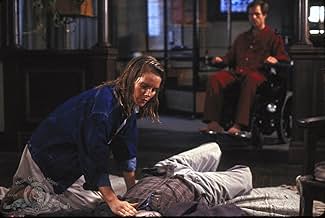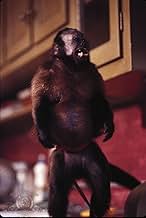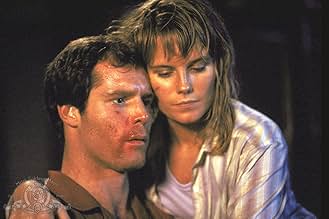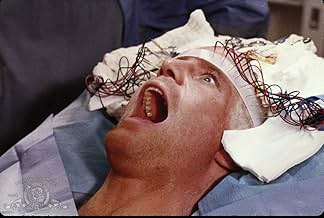NOTE IMDb
6,2/10
14 k
MA NOTE
Un paraplégique est assisté par un petit singe dressé, jusqu'à ce que ce dernier commence à développer des sentiments, et de la colère, à l'encontre de son nouveau maître.Un paraplégique est assisté par un petit singe dressé, jusqu'à ce que ce dernier commence à développer des sentiments, et de la colère, à l'encontre de son nouveau maître.Un paraplégique est assisté par un petit singe dressé, jusqu'à ce que ce dernier commence à développer des sentiments, et de la colère, à l'encontre de son nouveau maître.
- Réalisation
- Scénario
- Casting principal
- Récompenses
- 7 victoires et 2 nominations au total
Avis à la une
It seems that every once and a while, a neat little horror film comes along that eschews genre conventions and is able to tap into a new vein to provide its scares. Writer-director George A. Romero, of "Night of the Living Dead" (1968) and "Dawn of the Dead" (1978) infamy, brings forth "Monkey Shines," an adaptation of the novel by Michael Stewart.
Romero has always been a director who goes for the throat in delivering the shocks in his horror pictures. But in the savage gore and mayhem, he has never lost sight of the human characters, their drama, and their plight. In "Monkey Shines," Romero seems to have been domesticated somewhat - dare I say, "tamed" - in that characters and drama are most essential to the core of the film, and that horror is really the last thing on his mind.
"Monkey Shines" begins with the Good Day Gone Bad, Really Bad: Allan Mann (Jason Beghe), is a highly physical law student who goes for a jog early one morning after spending the night with his girlfriend Linda (Janine Turner). To avoid a dog on the sidewalk, he unknowingly runs into the path of an oncoming truck. He wakes up several weeks later in the hospital, now a quadriplegic, paralyzed, unable to use his body anywhere below the neck.
Confined to a wheelchair he moves around by working a lever with his mouth and having to rely on live-in nurse Maryanne (Christine Forrest), his doting, overbearing mother Dorothy (Joyce Van Patten) and having to deal with his pompous surgeon Dr. Wiseman (Stanley Tucci) who begins having an affair with Linda, Allan gives up and tries to commit suicide. Luckily, Allan's mad-scientist friend Geoffrey (John Pankow) may have a solution: Ella, an extremely intelligent capuchin monkey who is being trained by animal specialist Melanie Parker (Kate McNiel) to be a sort of help-primate for paraplegics and quadriplegics, much like a seeing-eye dog is used for blind people.
At first, a great weight seems lifted off Allan's shoulders; Ella's the perfect helper - she can answer the phone, play cassette tapes in the radio, and even help Allan turn the pages of his books when he reads. She even raises her hand in class for her turn to be called on. A deep bond develops between the two that's right out of any made-for-TV movie about hope and determination to beat the odds. Of course, and this is where the horror elements begin to kick in, what Allan doesn't know is that Ella is really Geoffrey's guinea pig in an experiment to create super-intelligent primates: he's been secretly injecting her with human brain tissue, which explains her super-intelligence in helping to make Allan's life a little bit easier. Even more horrifically, Allan has been having incredibly realistic nightmares in which he has acquired a monkey's-eye view of the world, and Ella is subconsciously acting out his deeply-suppressed anger, frustration, hatred, and rage for those around him. And it soon begins a battle of wits to see who is really controlling who, which also sees if Charles Darwin was really right all those years ago.
"Monkey Shines" develops so nicely during its first hour that it's easy to forget that first and foremost, it's a horror film and not just any horror film, a George A. Romero-directed horror film. Romero shows remarkable restraint in combining both the human story with the horror story, that both elements are given enough screen time to thoroughly develop and not seem so tacked-on to each other. That atmosphere and tension of the film's horror-themed second half is pretty intense, even if things can be forgiven for the haunted house-style climax.
This is easily the best-acted film Romero has ever directed, though obviously it's not his best; that honor goes to "Dawn of the Dead." All of the characters turn in fine and realistic performances, including John Pankow as Allan's drug-addled mad-scientist friend who truly has his friend's best interests at heart, even if they're morally gray in the end. But there is one performer who is highly deserving of much praise, and that is Jason Beghe. Jason Beghe delivers a strong, controlled central performance that in my opinion, was criminally overlooked by a great many awards organizations. His performance is one of the most convincing and sympathetic portrayals of a physically handicapped protagonist I've ever seen in the movies. Essentially a prisoner in his own body, he hits every emotive note perfectly, and we believe and can see where and why his anger and rage at his condition is one of the most believable performances in the history of Romero's long and distinguished career as a filmmaker.
"Monkey Shines" is an overlooked career highlight from a highly distinguished director, George A. Romero. Even more so, Jason Beghe's criminally underrated performance makes the film even more worthy of more significant praise.
This is one horror film that isn't monkeying around in the end. It is really scary.
8/10
Romero has always been a director who goes for the throat in delivering the shocks in his horror pictures. But in the savage gore and mayhem, he has never lost sight of the human characters, their drama, and their plight. In "Monkey Shines," Romero seems to have been domesticated somewhat - dare I say, "tamed" - in that characters and drama are most essential to the core of the film, and that horror is really the last thing on his mind.
"Monkey Shines" begins with the Good Day Gone Bad, Really Bad: Allan Mann (Jason Beghe), is a highly physical law student who goes for a jog early one morning after spending the night with his girlfriend Linda (Janine Turner). To avoid a dog on the sidewalk, he unknowingly runs into the path of an oncoming truck. He wakes up several weeks later in the hospital, now a quadriplegic, paralyzed, unable to use his body anywhere below the neck.
Confined to a wheelchair he moves around by working a lever with his mouth and having to rely on live-in nurse Maryanne (Christine Forrest), his doting, overbearing mother Dorothy (Joyce Van Patten) and having to deal with his pompous surgeon Dr. Wiseman (Stanley Tucci) who begins having an affair with Linda, Allan gives up and tries to commit suicide. Luckily, Allan's mad-scientist friend Geoffrey (John Pankow) may have a solution: Ella, an extremely intelligent capuchin monkey who is being trained by animal specialist Melanie Parker (Kate McNiel) to be a sort of help-primate for paraplegics and quadriplegics, much like a seeing-eye dog is used for blind people.
At first, a great weight seems lifted off Allan's shoulders; Ella's the perfect helper - she can answer the phone, play cassette tapes in the radio, and even help Allan turn the pages of his books when he reads. She even raises her hand in class for her turn to be called on. A deep bond develops between the two that's right out of any made-for-TV movie about hope and determination to beat the odds. Of course, and this is where the horror elements begin to kick in, what Allan doesn't know is that Ella is really Geoffrey's guinea pig in an experiment to create super-intelligent primates: he's been secretly injecting her with human brain tissue, which explains her super-intelligence in helping to make Allan's life a little bit easier. Even more horrifically, Allan has been having incredibly realistic nightmares in which he has acquired a monkey's-eye view of the world, and Ella is subconsciously acting out his deeply-suppressed anger, frustration, hatred, and rage for those around him. And it soon begins a battle of wits to see who is really controlling who, which also sees if Charles Darwin was really right all those years ago.
"Monkey Shines" develops so nicely during its first hour that it's easy to forget that first and foremost, it's a horror film and not just any horror film, a George A. Romero-directed horror film. Romero shows remarkable restraint in combining both the human story with the horror story, that both elements are given enough screen time to thoroughly develop and not seem so tacked-on to each other. That atmosphere and tension of the film's horror-themed second half is pretty intense, even if things can be forgiven for the haunted house-style climax.
This is easily the best-acted film Romero has ever directed, though obviously it's not his best; that honor goes to "Dawn of the Dead." All of the characters turn in fine and realistic performances, including John Pankow as Allan's drug-addled mad-scientist friend who truly has his friend's best interests at heart, even if they're morally gray in the end. But there is one performer who is highly deserving of much praise, and that is Jason Beghe. Jason Beghe delivers a strong, controlled central performance that in my opinion, was criminally overlooked by a great many awards organizations. His performance is one of the most convincing and sympathetic portrayals of a physically handicapped protagonist I've ever seen in the movies. Essentially a prisoner in his own body, he hits every emotive note perfectly, and we believe and can see where and why his anger and rage at his condition is one of the most believable performances in the history of Romero's long and distinguished career as a filmmaker.
"Monkey Shines" is an overlooked career highlight from a highly distinguished director, George A. Romero. Even more so, Jason Beghe's criminally underrated performance makes the film even more worthy of more significant praise.
This is one horror film that isn't monkeying around in the end. It is really scary.
8/10
This movie's not going to have a fan base larger than Night of the Living Dead or Dawn of the Dead, but it is another example of Romero's uniqueness as s film maker. An original story with an original cast, Romero adds to the horror genre by going somewhere where no other film maker has gone before. Monkey Shines cast includes Christine Forrest who shows her finest performance as the nurse. Worth checking out, so check it out.
Aah, George A Romero - the master himself - does it again. This is a very stylish thriller and perfect study of how man's apparent progress goes horribly wrong.
The film captured my attention from the opening moment. Jason Beghe is perfectly cast in this demanding role. It was interesting (if somewhat creepy) to see how things started going wrong, very subtle at first, and how the situation declined to absolute chaos and mayhem. The romance interest felt very natural and enjoyable. Quite often the romance feels forced into a film; here it seemed inevitable given the circumstances.
This is a true classic!
The film captured my attention from the opening moment. Jason Beghe is perfectly cast in this demanding role. It was interesting (if somewhat creepy) to see how things started going wrong, very subtle at first, and how the situation declined to absolute chaos and mayhem. The romance interest felt very natural and enjoyable. Quite often the romance feels forced into a film; here it seemed inevitable given the circumstances.
This is a true classic!
While this will likely never be considered one of filmmaker George Romero's best, it still represents a commendable effort in one of his rare forays into studio productions (in this case Orion). Scripted by Romero based on a novel by Michael Stewart, it tells the story of Allan Mann (handsome Jason Beghe), a law student who gets into a horrible accident that renders him a quadriplegic. He soon becomes despondent enough to attempt suicide, but soon he receives some temporary salvation in the form of Ella (Boo), a capuchin monkey who is trained to see to his needs. What he doesn't know is that his friend Geoffrey (John Pankow) has been playing mad scientist and injecting the cute lil' thing with human brain cells. Soon the bond between patient and helper becomes so strong that a mental connection is made, and Ella is physically acting out Allan's worst impulses. So what is he going to do about this little homicidal primate? Romero does a good job here at telling a fairly interesting story, although some viewers might be turned off at the lack of sympathetic characters. Most of them are flawed to some degree or another - creepy dean Burbage (Stephen Root), smarmy, incompetent doctor Wiseman (Stanley Tucci), fair-weather girlfriend Linda (Janine Turner), bitchy nurse Maryanne (Christine Forrest, a.k.a. Mrs. Romero) - and even a guy like Geoffrey, who initially just wants to help, has his problems as he's obsessed with his work. At least Allan has an appealing love interest played by Kate McNeil, whom horror fans will recognize as the lead in the slasher "The House on Sorority Row". The cast is pretty good overall; Joyce Van Patten plays the stereotypically smothering mother to good effect, and it's a treat to see character actors Root and Tucci near the beginnings of their careers, but the one performer the audience is likely to remember is Boo, who's adorable and very well trained; the animal action is first rate throughout (there's also a rather annoying bird on hand). The evolving relationship between Allan and Ella makes for a compelling hook, and it makes one appreciate the real-life efforts that people put into training service animals, and the animals themselves. The film is light on horror - most of the violence is implied - as Romero tends to go for a more psychological approach, and refrains from going for the gore. Overall, this is a decent flick, worth a look for genre fans who are interested in checking out Romero's non-zombie films. Seven out of 10.
If you're looking for body count, blood, or bogeymen, this film is not for you. It is more of a psychological thriller than a horror film, though it was billed as horror, likely because of the pseudo-science gimmick that provides the basis for the conflict in the plot.
While the film tends to wander a bit (i.e. a sub-plot involving the research head that gets dropped 3/4 of the way through) it stays fairly well focused on the main character and his problems. Aside from the lead, the most effective acting was done by the monkey(s), but the "real" actors do a pretty good job of carrying their own. It gives you a little insight into what it's like to be quadriplegic. For a late 80's movie, the style of filming was well done, there is very little cheese, and the special effects didn't overreach.
The premise seems a bit farfetched to our currently more sophisticated and informed sense of what's possible on the genetic engineering front. After all, this movie was made 15 years ago. If Romero had gone with either a supernatural cause or a plain animal jealousy angle, it might be less dated, but then again it might have been a little less believable to begin with.
Not very horrific, not startling or scary, but worth seeing if you don't mind a slightly slow-paced thriller. I gave it a higher than average score (6 out of 10) just because it didn't make me say "oh, please!" too many times unlike other movies from that time--particularly horror films--are prone to do. For example, the pivotal moment is fully supported by plausible input earlier in the film, it's not one of those miraculous developments pulled out of nowhere in the last few seconds before the climax.
While the film tends to wander a bit (i.e. a sub-plot involving the research head that gets dropped 3/4 of the way through) it stays fairly well focused on the main character and his problems. Aside from the lead, the most effective acting was done by the monkey(s), but the "real" actors do a pretty good job of carrying their own. It gives you a little insight into what it's like to be quadriplegic. For a late 80's movie, the style of filming was well done, there is very little cheese, and the special effects didn't overreach.
The premise seems a bit farfetched to our currently more sophisticated and informed sense of what's possible on the genetic engineering front. After all, this movie was made 15 years ago. If Romero had gone with either a supernatural cause or a plain animal jealousy angle, it might be less dated, but then again it might have been a little less believable to begin with.
Not very horrific, not startling or scary, but worth seeing if you don't mind a slightly slow-paced thriller. I gave it a higher than average score (6 out of 10) just because it didn't make me say "oh, please!" too many times unlike other movies from that time--particularly horror films--are prone to do. For example, the pivotal moment is fully supported by plausible input earlier in the film, it's not one of those miraculous developments pulled out of nowhere in the last few seconds before the climax.
Le saviez-vous
- AnecdotesThis was the first film role for Stephen Root, then a stage actor. According to Root, he had been instructed by his agent not to let the casting directors know that he was inexperienced with film as an actor. Root's official debut was Crocodile Dundee II (1988), which had been released in theaters a month before this film, despite being shot a month after it.
- GaffesFisher incorrectly refers to performing an "autopsy" on Ella. An autopsy is performed on human remains. The correct term for examining animal remains postmortem is "necropsy". This is a common mistake for most people, one that Fisher would not make, given his profession.
- Citations
Geoffrey Fisher: You're a clinical cunt.
- Crédits fous"Introducing Boo as Ella"
- Versions alternativesEarlier versions of Monkey Shines allegedly contained a bizarre brain surgery scene, as well as several abusive scenes involving the small monkey, Ellie. Although the scenes were all staged and no animals were harmed in the making of the movie, the filmmakers decided it would be better to simply leave them out to avoid conflicts.
- ConnexionsFeatured in Document of the Dead (1980)
Meilleurs choix
Connectez-vous pour évaluer et suivre la liste de favoris afin de recevoir des recommandations personnalisées
- How long is Monkey Shines?Alimenté par Alexa
- Do disabled people in real life ever use monkeys for help around the house?
Détails
- Date de sortie
- Pays d’origine
- Langue
- Aussi connu sous le nom de
- Atracción diabólica
- Lieux de tournage
- Société de production
- Voir plus de crédits d'entreprise sur IMDbPro
Box-office
- Budget
- 7 000 000 $US (estimé)
- Montant brut aux États-Unis et au Canada
- 5 344 577 $US
- Week-end de sortie aux États-Unis et au Canada
- 1 902 024 $US
- 31 juil. 1988
- Montant brut mondial
- 5 344 577 $US
Contribuer à cette page
Suggérer une modification ou ajouter du contenu manquant

Lacune principale
By what name was Incidents de parcours (1988) officially released in India in English?
Répondre
































